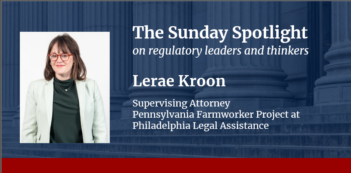
An overlooked Supreme Court decision may give courts more discretion to second-guess the NLRB.
The Supreme Court issued several decisions this past term that limited the legal protections provided to the public by federal agencies. This attack on agencies at the Supreme Court is not over, as additional petitions to limit agency powers are afoot.
One decision from this past term—Starbucks v. McKinney—may not have received as much attention despite representing another rejection of the expertise of a key federal agency, the National Labor Relations Board (NLRB). The NLRB, pursuant to its enforcement responsibilities under the National Labor Relations Act (NLRA), seeks to protect the rights of workers to engage in concerted activities without coercion or interference from their employers.
The Court in Starbucks agreed to answer whether a lower federal court applied the wrong test in issuing an injunction pursuant to Section 10(j) of the NLRA by reinstating seven Starbucks workers who were terminated. These workers were terminated during a union organizing campaign in Memphis, Tennessee. Section 10(j) gives the NLRB the power, after issuing a complaint against any person the Board is charging with an unfair labor practice, to seek an injunction in federal court granting that “such temporary relief or restraining order as it deems just and proper.”
Some federal courts had applied a two-part test in deciding Section 10(j) injunctions cases: (1) whether there is “reasonable cause” to believe an unfair labor practice has occurred, and (2) whether granting an injunction would be “just and proper.”
Other federal courts had applied a traditional four-part test. As I have recently explained elsewhere, this test may operate as follows:
First, the courts ask whether the unfair labor practice case is likely to succeed on the merits in establishing that labor violations occurred. Second, they look to see if the workers the NLRB is attempting to protect will face irreparable harm without an injunction. Third, after showing likelihood of success and irreparable harm, they ask whether those factors outweigh any hardships the employer is likely to face due to compliance with the court’s order. Fourth, they ask whether issuing the injunction serves the public interest.
During oral argument before the Supreme Court, resolving the Starbucks case seemed so straightforward that one might have assumed it would have led to a quick per curiam opinion. Chief Justice John Roberts asked the attorney who represented the NLRB: “Do you agree with your friend on the other side that we can dispose of this in a short opinion?” Then, laughter ensued.
The Court did ultimately decide, in an 8-1 ruling, that the four-factor test applies.
Nevertheless, Justice Ketanji Brown Jackson’s opinion, which concurred in part and dissented in part, demonstrates some of the concerns that the traditional four-part test presents.
Why was the need to clarify the injunction test a question worthy of the Court’s time? Yes, a conflict appeared over the application of two different tests by the courts of appeal. However, the question in the Starbucks case failed to involve facts teed up perfectly for the Court to decide not only the test to be applied but also how to apply that test on the merits.
The NLRB rarely seeks 10(j) injunctions. Yet, Starbucks challenged the test the court used to grant the 10(j) injunction in its case even after one report noted that NLRB administrative law judges found Starbucks had committed unfair labor practices in 48 out of 49 cases. In addition, Starbucks continued its Supreme Court appeal even after it agreed in February 2024 to negotiate a collective bargaining agreement with the union that had organized the Memphis employees. As a result, there was no significant injury to be rectified by changing the injunction test to be used in this case.
Justice Jackson’s powerful dissent explains the possible harm that may come from the Starbucks decision. Justice Jackson notes that the Court gave a tremendous amount of discretionary power to federal court judges to second-guess NLRB actions when pursuing 10(j) injunctions.
In addition, the Court failed to distinguish between the role of an agency like the NLRB in being authorized by Congress to seek a 10(j) injunction, and the role of a typical private plaintiff seeking an injunction. The NLRB is “the decider of the merits of the underlying dispute” when it uses 10(j) to protect its ability to remedy unfair labor practices before its proceedings end. This raises unique questions about one element in the four-part test—the likelihood of success on the merits for an agency like the NLRB. The Starbucks Court did not really address those questions.
The import of the Court’s ruling in Starbucks is not about which test applies. Rather, the Court deemphasized the expert role of the NLRB in deciding the merits and focused on the unbridled discretion that a court may use. By resolving the question absent a specific case, the Court has failed to consider the broader implications of its ruling and needlessly injected its views. As a result, there is no context to understand how to apply the decision in Starbucks. On remand, even after a lower court applies the four-part test that Starbucks argued for, the company is arguably likely to lose. Would that result represent anything but a pyrrhic victory for Starbucks?
One could surmise that this Supreme Court appeal was part of a larger business plan to eliminate the NLRB’s power to decide labor disputes. In a 2023 Federalist Society Review article, one opponent of the NLRB argued that the NLRB violates Article III of the U.S. Constitution by making legal interpretations relegated to the courts. Project 2025, a report published by The Heritage Foundation, provides a broad plan to diminish the powers of government agencies. Republican Senator Mike Lee (R-Utah) reportedly referred to Project 2025 as a “blueprint” for “the next conservative president” to “dismantle the administrative state and return power back to the states and the American people.”
The Starbucks decision, along with other decisions during this Court’s term, provides another step toward accomplishing the goal of complete dismantlement of agency power. Some observers may see the Court’s recent decisions as beneficially reigning in agency flip-flopping. I view front-line decisions by experienced labor lawyers from both sides of the aisle as the better alternative, as the Board’s expertise over thorny labor law questions helps achieve more valuable labor law developments than decisions by inexpert federal judges.
This essay is part of a series, titled The Supreme Court’s 2023-2024 Regulatory Term.




